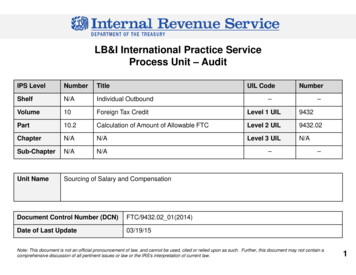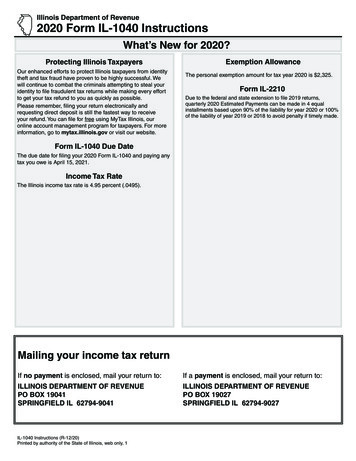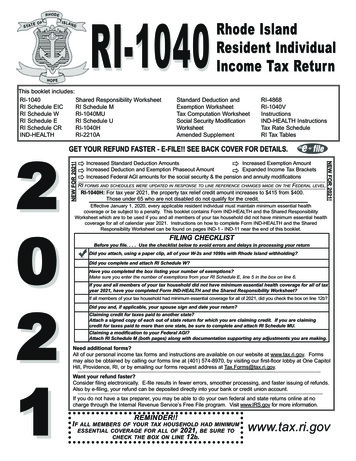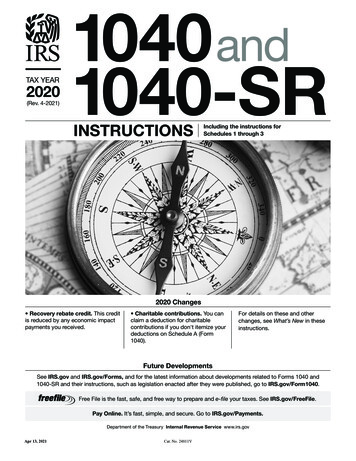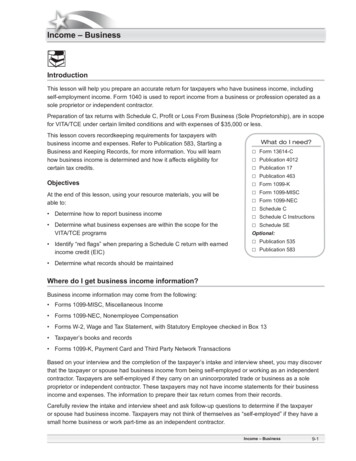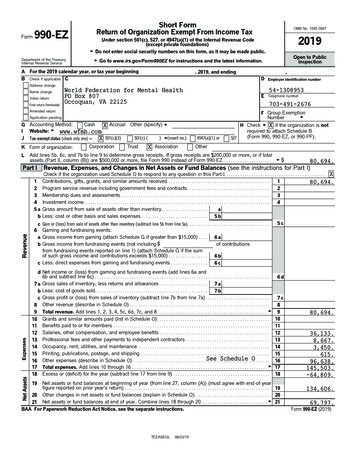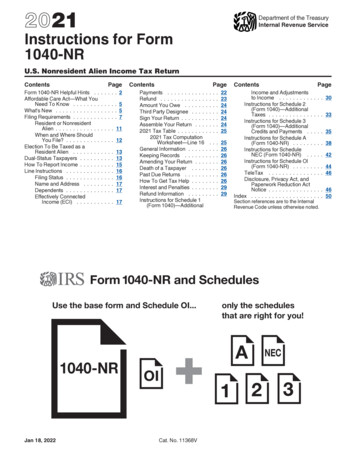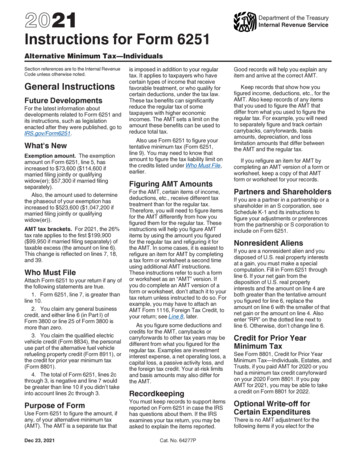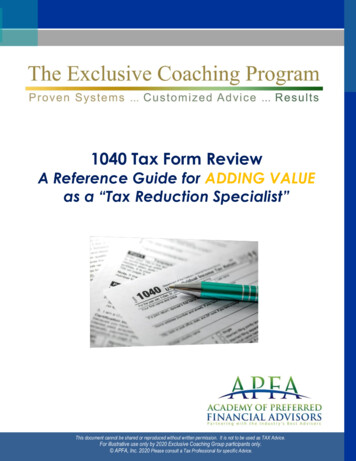
Transcription
8O1040 Tax Form ReviewA Reference Guide for ADDING VALUEas a “Tax Reduction Specialist”This document cannot be shared or reproduced without written permission. It is not to be used as TAX Advice.For illustrative use only by 2020 Exclusive Coaching Group participants only. APFA, Inc. 2020 Please consult a Tax Professional for specific Advice.
Pag e 2How to Become a Tax Reduction SpecialistTaxes, taxes, taxes. Most advisors that we work with have clients and prospects that have a love/hate relationshipwith taxes. They love to reduce their taxes and they hate paying their taxes. As an advisor who offerscomprehensive financial advice, a key component of your Financial Check-up is to review your client's tax returnsand provide tax reduction strategies.We are not suggesting you act as a tax preparer. Instead, we are suggesting you become a "Tax ReductionSpecialist." One phrase we love sharing with clients and prospects is:"We don't care who prepares your taxes, we just want to reduce your taxes!"Our goal is to take a proactive approach to reducing taxes. We all know the advantages of proactive versusreactive. This is why we often use this phrase as well with clients and prospects:"What can we do today to reduce your taxes tomorrow?"In order to actually implement that line and for us to share "not just what to do, but how to do it ," you willneed to learn how to read and use a tax return.Why should you do this?Amongst the many reasons are: It illustrates your knowledge and experience. It ADDS VALUE and therefore helps justifies your fee. It differentiates you from most of your competition - and also makes you a much more valuable resource tothe client; in fact, most financial advisors do not even look at a client's tax return. It shows the client that you truly care about their financial issues and that you are giving specific advicerather than generic advice. It helps you bring up things that other financial advisors have not. This is one of the easiest and mostobvious things that distances you and sets you apart from your competition. It helps you in assisting qualified clients and prospects achieve their most common goal, which is typicallyto minimize their tax bill. It gives you insight to your client's past, present and future financial behavior and the degree of concernthat they have in reducing taxes. It gives you a better understanding of your client's or prospect's investing and/or buying decisions. It helps you discover additional investments that you may not already be aware of. IT IS ESSENTIAL, IF YOU WANT TO DO WHAT IS IN YOUR CLIENT'S BEST INTEREST.This document cannot be shared or reproduced without written permission. It is not to be used as TAX Advice.For illustrative use only by 2020 Exclusive Coaching Group participants only. APFA, Inc. 2020Please consult a Tax Professional for specific Advice.
Pag e 3We are not suggesting you prepare tax returns, but rather review them.In order to fully recommend tax strategies that are best for your clients, you need to have the facts. If you do notgather this essential data by reviewing a client's or prospect's tax return, you can't make educatedrecommendations for clients or prospects.How do you do this?First and foremost, we suggest you think like a doctor when you look at the tax returns, such as: Look for symptoms;Look for things that are not within a "reasonable range";Identify items that warrant further investigation; andBring in a tax specialist when necessary to assist you in correctly assessing a specific course of action.Does the client's or prospect's information on their tax return make sense?At this point, you need to think like an IRS auditor. Take a look at things from the perspective of trying to avoidany IRS radars. You want to make sure that you do not cause your client any problems and that you are accuratein all your information.Anyone who is not well versed in taxes should consider taking a tax course, even if it is online. For purposesof this module, let's examine some information that can help you now!Let's now examine the tax return itself. First you need to determine if the information shows something thatappears to be inconsistent, unusual, or may not be accurate. Important issues to consider are: Most numbers on a tax return that end with multiple zeros are only estimates. Does their income match the neighborhood or lifestyle in which they live? If you are comparing the prospect’s most recent tax returns to their tax returns in prior years, are thereany major differences, changes, or patterns? Significant changes year-by-year is a major indicator of lackof proper and adequate income tax reduction strategies. This is the same strategy typically used by mostauditors to determine how consistent someone is. Ask this tax question, "Don't you think it would be wise to know what the tax consequence would be onany financial transactions before the transaction takes place?" At this point you can determine whetheror not they have the proper basic information for their investments to even consider the tax impact. "How often does your financial advisor look at your tax return?" If the answer is never, then ask: "Ifyour advisor doesn't look at your tax return, how does your advisor know the tax consequences of anyrecommended transactions?"This document cannot be shared or reproduced without written permission. It is not to be used as TAX Advice.For illustrative use only by 2020 Exclusive Coaching Group participants only. APFA, Inc. 2020Please consult a Tax Professional for specific Advice.
Pag e 4How Do Federal Income Taxes Work?The federal individual income tax has seven tax rates that rise with income. Each rate applies only toincome in a specific range (tax bracket).CURRENT INCOME TAX RATES AND BRACKETSThe federal individual income tax has seven tax rates ranging from 10 percent to 37 percent (see table). The ratesapply to taxable income—adjusted gross income minus either the standard deduction or allowable itemizeddeductions. Income up to the standard deduction (or itemized deductions) is thus taxed at a zero rate.Federal income tax rates are progressive: As taxable income increases, it is taxed at higher rates. Different taxrates are levied on income in different ranges (or brackets) depending on the taxpayer’s filing status. In 2019, thetop tax rate (37 percent) applies to taxable income over 510,300 for single filers and over 612,350 for marriedcouples filing jointly. Additional tax schedules and rates apply to taxpayers who file as heads of household andto married individuals filing separate returns. A separate schedule of tax rates applies to capital gains anddividends. Tax brackets are adjusted annually for inflation.BASICS OF PROGRESSIVE INCOME TAX RATESEach tax rate applies only to income in a specific tax bracket. Thus, if a taxpayer earns enough to reach a newbracket with a higher tax rate, his or her total income is not taxed at that rate, just the income in that bracket. Evena taxpayer in the top bracket has some portion of income taxed at the lower rates in the tax schedule. For example,a single filer with 50,000 in taxable income falls into the 22 percent bracket but does not pay tax of 11,000 (22This document cannot be shared or reproduced without written permission. It is not to be used as TAX Advice.For illustrative use only by 2020 Exclusive Coaching Group participants only. APFA, Inc. 2020Please consult a Tax Professional for specific Advice.
Pag e 5percent of 50,000). Instead, he or she pays 10 percent of 9,700, then 12 percent till 39,475 plus 22 percent ofthe last 11,525 for a total of 7,078.50.All tax brackets for married taxpayers are twice the size of those for singles, except for the penultimate bracket.This can cause a “marriage penalty” for some taxpayers in the highest tax bracket, as some couples pay more taxfiling a joint return than they would if each spouse could file as a single person. Conversely, because most taxbrackets for married couples are twice the size of those for singles, many married couples enjoy a “marriagebonus,” paying less in tax by filing jointly than they would if each partner filed as a single person.HISTORY OF FEDERAL INCOME TAX BRACKETS AND RATESOver the 100-plus year history of the modern federal income tax (short-lived income taxes existed before ongressratified the 16th Amendment in 1913), the number of brackets and rates have changed dramatically and frequently.The federal income tax began with seven brackets but that number exploded to more than 50 by 1920 (figure 1).From then until the late 1970s, there were never fewer than 20 brackets. The last major federal tax reform, theTax Reform Act of 1986, reduced the number of brackets from 16 to two, but that number has crept up to thecurrent seven over the last three decades. The Tax Cuts and Jobs Act (TCJA) lowered the top rate to 37 percentstarting in 2018. Due to certain budgetary constraints, the TCJA contains a “sunset,” or an expiration date, formany of its provisions including the new tax rates on January 1, 2026.Capital Gains TaxesIn 2019 the capital gains tax rates were either 0%, 15% or 20% for most assets held for more than a year. Capitalgains tax rates on most assets held for less than a year correspond to ordinary income tax brackets (10%, 12%,22%, 24%, 32%, 35% or 37%).Capital gains are the profits from the sale of an asset — shares of stock, a piece of land, a business — and generallyare considered taxable income. A lot depends on how long you held the asset before selling.This document cannot be shared or reproduced without written permission. It is not to be used as TAX Advice.For illustrative use only by 2020 Exclusive Coaching Group participants only. APFA, Inc. 2020Please consult a Tax Professional for specific Advice.
Pag e 6Short-term capital gains tax is a tax on profits from thesale of an asset held for one year or less. Short-termcapital gains tax rates equal your ordinary income taxrate — your tax bracket.Long-term capital gains tax is a tax on profits from thesale of an asset held for more than a year. Long-termcapital gains tax rates are 0%, 15% or 20% dependingon your taxable income and filing status. They aregenerally lower than short-term capital gains tax rates.Some easy VALUE ADDED things to lookfor on a tax return include: Marginal tax bracket.This is an easy thing to identify. Take a look at the taxable income on Form 1040, page 1 - Line 11b, in order todetermine their marginal Federal tax bracket. Incorporate this into after-tax savings any time you make a taxreduction recommendation or any investment recommendations. If the client has a negative taxable income(which happens in rare instances - but we do see them especially for retirees, small business owners and investorsof rental property), this usually indicates poor or no income tax planning. It is an opportunity to bring in moretaxable income without paying any taxes (like through the use of a partial Roth IRA conversion). Look at taxable interest Line 2b of 1040.Their taxable interest is on line 2b This is separate from line 2a – tax exempt interest. Calculate their after-taxROI, which is their interest rate earned on their investments less their marginal tax bracket. Remind them "It's notwhat you earn, it's what you keep!" At that point you can let them know that ALL of this income is subject totaxes! If appropriate you might suggest that “Something we MIGHT EXPLORE would be possible otherstrategies, with tax advantages” (this can include municipal bonds, deferred annuities, qualified dividend stocks,growth-oriented investments or other types of investments that do not generate immediate taxable income). If themajority of this comes from bank accounts, the next thing is to divide the taxable interest by 1% or ½%, (whichis about the average interest rate many savers earn in their bank accounts). They probably have more than thisamount in CDs, money markets and bank accounts. Compare this number to the amount they gave you.Remember: Any interest that they earned on a taxable bond could be greater than the 1 or ½% and therefore wemust take this into consideration when making this estimate. Tax-exempt interest, line 2a on 1040.This is generally generated from municipal bonds. This amount is not included on line 2b. Divide this tax-freeinterest by 1 or 2% and this can offer a reasonable guesstimate amount they might have in municipals. Comparethis to the amount they gave you. These investments usually make sense only if the client is in a 32% or highermarginal tax bracket. Discuss with the client their tax sensitivity and what motivated them to invest in these taxfree investments.This document cannot be shared or reproduced without written permission. It is not to be used as TAX Advice.For illustrative use only by 2020 Exclusive Coaching Group participants only. APFA, Inc. 2020Please consult a Tax Professional for specific Advice.
Pag e 7 Ordinary Dividends, Line 3b on 1040.Ordinary dividends, line 3b, include both qualified dividends – the amount shown on line 3a (these qualify forspecial tax treatment) and non-qualified dividends, which is the difference between ordinary dividends andqualified dividends. Non-qualified dividends receive no special tax treatment and are subject to ordinary incometaxes. Qualified dividends are typically generated from stocks and non-qualified dividends are usually generatedfrom money market or bond fund accounts. Divide the non-qualified dividends by 1 or ½% and this is thereasonable guesstimate amount they should have in money market accounts. Compare this number to what theygave you. At this point, determine the amount they should have liquid and whether it is sufficient. We find thatmany clients, especially older ones, have far more liquidity than they need. Qualified dividends, Line 3a of 1040.These dividends are generated from stocks and receive special tax treatment. They are income tax-free if yourmarginal tax bracket is 12% or less, and still only taxed at a 15% or 20% at higher tax rates (see chart on earlierpage). They also can be taxed at 3.8% higher, if you are subject to the Medicare tax.Discuss with the prospect/client that one of the strategies is to pay attention to always keeping when achievablethe tax rate on dividends as low as possible. The major issue here is to illustrate that you are taking a proactiveapproach to help reduce their taxes and providing advice that most other advisors don’t even consider. Look at Schedule B – interest, line 4 and ordinary dividends, line 6.Look at Schedule B for multiple numbers of institutions listed. Then compare this information to your notes anda copy of your client's or prospect's other brokerage statements to gather some valuable data to help you in yourfinancial review: This will assist with determining what their total assets are and where they are holding these assetsTo identify if they have the cost basis and unrealized gains and lossesYou can confirm if the statements are titled properlyYou may at this point want to ask them if they are interested in reducing paperwork and discuss the value ofconsolidating accounts. You also may want to talk about the following: "Imagine if you had one 1099 ratherthan and ask yourself, ‘wouldn't it be easier? Do any of your financial advisors providecomprehensive advice and look at your total portfolio? Do you think it would be a good idea to look at yourentire financial picture rather than just part of it?” Capital gains and losses, Schedule D.Look at Schedule D and see if there is a lot of activity. If the client is makinga lot of trades, they may want to consider doing these trades in an IRA orqualified retirement account. Also, look for their brokerage statements thatback up these trades and provide you additional important information abouttheir accounts, investment strategies, and cost basis.Does line 16 (page 2) have a gain? Has anyone talked with them about“harvesting” which is matching up any recognized gains with losses. Thissaves tax dollars. The maximum taxable loss that can show on this line 16 isThis document cannot be shared or reproduced without written permission. It is not to be used as TAX Advice.For illustrative use only by 2020 Exclusive Coaching Group participants only. APFA, Inc. 2020Please consult a Tax Professional for specific Advice.
Pag e 8 3,000. If this number is (- 3,000), there probably is additional capital losses that can be carried over into thenext tax year. These show up on Schedule D.Next, look at line 15 on page 1 of Schedule D, which is net long-term capital gains and losses and also look at theamount on line 7, which is net short-term capital gains and losses. The tax on short term capital gains is usuallytaxed at ordinary income tax rates (up to 37%) which is significantly higher than the tax on long term capitalgains, which can be as low as 0% and a maximum tax rate of 20%! One of the best strategies is to wait one yearbefore selling any appreciated property in order to pay a lower tax. At this point you can discuss those advantageswith prospects and clients.Also, you should review all brokerage accounts, to discuss or compute unrealized capital gains and losses, andconsider various tax strategies. At this point you can find many clients are taking much higher investment risksthan they informed you of. This can help you start discussing your value, which could also include reducing theirrisk.You can review tax reduction strategies, but if you are unsure, you should work with aqualified tax professional to discuss the specifics.For lower tax bracket clients, one major tax reduction strategies regarding capital gains is to sell enoughinvestments that have unrealized capital gains that will generate additional long-term capital gains up to the topof the client’s 12% tax bracket. For example, if the taxpayer is married and filing a joint return, they can have ataxable income of 78,950 and still be only in the 12% tax bracket in 2019. For example, if your married filingjointly client has a projected taxable income of 40,000, and they generate an additional 35,000 of taxableincome, they still remain in the 12% tax bracket. In this case, if you sell any investments that will generate along-term capital gain, they stay at a 0% capital gain tax and this now is Federal income tax free!The next step is to look at their cost basis information that shows on Schedule D, page 1, column (e) and theirrealized capital gains and losses, which is on column (h). These are the actual sales that took place last year andthe profits or losses are considered “realized” capital gains and losses. Unfortunately, in many cases investors realcost basis sometimes can be calculated incorrectly(because of untracked dividend reinvestments).Errors occur frequently when calculating the cost basis on both investments that have been sold and thoseinvestments still in their brokerage accounts. Capital gains and losses on these investments that have not yet beensold are considered “unrealized.” We suggest informing prospects that, “We don’t want you to pay any moretaxes than you legally have to!” Discuss how cost basis is calculated, including the step-up in basis rules for thosewho inherit investments. Also, briefly discuss the various mistakes that are very common when computing thecost basis including the community property tax laws. If you can, offer to recheck the basis listed on their taxreturns and confirm that the capital gains and losses are correct, ONLY if they become a client! In manycases, the net capital gains or losses shown on the tax return are off by a significant margin and then you canrecommend they check with their tax preparer about amending their tax return (you can go back for 3 years if youfind that they can get a sizeable tax refund). You might also offer to recheck and recalculate their cost basis andunrealized capital gains and losses on the investments that they still own. Sometimes, this simple, basic 5-10minute conversation has a major impact on the prospect and is often the most influential factor of why the prospectwill become a client and transfer their accounts over to you from another financial advisory firm in only a shortperiod of time.Perception is reality and tax savings strategies have probably the biggest VALUE ADDEDimpact for most investors!This document cannot be shared or reproduced without written permission. It is not to be used as TAX Advice.For illustrative use only by 2020 Exclusive Coaching Group participants only. APFA, Inc. 2020Please consult a Tax Professional for specific Advice.
Pag e 9 IRA, Pension and Annuity Distributions on lines 4a, 4b, 4c, 4dLine 4a and 4c, on form 1040, show IRA, Pension and annuity distributions. Lines 4a and 4c show the grossamounts distributed from one or more of these vehicles, and Lines 4b and 4d are the taxable amounts, (which iszero if these distributions are rolled over into a new IRA or were used for a Qualified Charitable Distribution(QCD)).This entry would show a tax-free 1035 exchange from an annuity at one insurance company that was transferredover to an annuity at a different insurance company. The gross distribution is the amount that got transferred outof the prior company and this is usually sent directly to the other insurance company and therefore there is notaxable event since the client did not actually receive any of the distributions – it went directly to the otherinsurance company without passing through to the client first. Finally, look at their total tax on Line 16 on the 1040.Think to yourself - would you be happy?Ask, "Do you know how much you paid in taxes last year?" Advisors oftenhear the response “I never pay any taxes – I always get a refund!”You then can share two numbers that can put things in perspective, theirOverall Tax Rate and Marginal Tax Rate.First divide line 16 by line 11b. This will give you their Overall tax rate paid.For example, it could be 21% of their income went to Federal taxes. Thenlook at where line 11b lands on the income tax chart (on earlier page). Thiscould be 32% for a single filer with 165,000 on line 11b. This is their Marginal Tax Rate, or if you save themeven 1, how much of that they save in taxes. This can add up fast and, in many cases, pay for your serviceseasily. If they are a prospect and they paid more than you thought they should have, then inform the prospect ofthis amount, and in most cases, they could be very shocked and can hardly believe it. You should consider sayingthe following to the prospect, "You are known in the industry as being very patriotic.Unfortunately, many people are not aware of all the different tax reduction strategies that theyare eligible for because no one has been thorough with these possibilities. Always know youroptions, because one of your options is to do nothing."While this list of tax reduction ideas is only a partial one and should not be mistaken for comprehensive taxinformation and advice, we hope it gives you some guidelines, strategies, and understanding of some of the verybasic tax reduction ideas that can help you do a good job and be a major factor in reducing your clients’ taxes.Obviously, our tax reviews for clients are much more comprehensive and personalized than this workbook. Thissimple and basic review is merely an illustration of how we can help the client and our own education of thesedifficult topics.We know that reviewing a tax return takes knowledge and time but it is an important and necessary service inorder to provide comprehensive financial planning.As we always say, our goal is to share with you notjust what do to, but how to do it! This document cannot be shared or reproduced without written permission. It is not to be used as TAX Advice.For illustrative use only by 2020 Exclusive Coaching Group participants only. APFA, Inc. 2020Please consult a Tax Professional for specific Advice.
P a g e 101040 Review Checklist 1040 Line 1: Wages, Salaries, Tips, (W-2’s)1040 Line 2b: Taxable Interest1040 Line 2a: Tax-Exempt Interest1040 Line 3b: Ordinary Dividends1040 Line 3a: Qualified Dividends1040 Line 4a/4c: IRA, Pension and Annuity Distributions1040 Line 4b/4d: Taxable Amount (IRA, Pension and Annuity Distributions)1040 Line 5a: Social Security1040 Line 5b: Taxable Amount (Social Security)1040 Line 6: Capital Gains or (losses)1040 Line 9: Itemized Deductions (Schedule A) or Standard Deduction1040 Line 10: Qualified Business Income Deduction1040 Line 11b: Taxable Income1040 Line 16: Total Tax1040 Line 19:Taxes Paid1040 Line 20: Amount Overpaid1040 Line 23 Amount You Owe1040 Line 24 Estimated Tax PenaltySchedule B Lines 1,4 & 5,6: Taxable Interest & Dividend IncomeSchedule D Line 6: Short-Term Capital Loss CarryoverSchedule D Line 7: Net Short-Term Capital Gain or LossSchedule D Lines 8a-10: Long-Term Capital Gains or LossSchedule D Line 13: Capital Gain DistributionsSchedule D Line 14: Long-Term Capital Loss CarryoverSchedule D Line 15: Net Capital Gain or LossSchedule A Lines 1, 3 & 4: Itemized Deductions – Medical & Dental ExpensesSchedule A Lines 5-7: Itemized Deductions – Taxes You PaidSchedule A Line 10: Itemized Deductions –– Home Mortgage InterestSchedule A Lines 11-14 Itemized Deductions – Gifts to CharitySchedule A Line 17: Total Itemized DeductionsSchedule 1: Other write-offs: Especially Business Owners and EducatorsThis document cannot be shared or reproduced without written permission. It is not to be used as TAX Advice.For illustrative use only by 2020 Exclusive Coaching Group participants only. APFA, Inc. 2020Please consult a Tax Professional for specific Advice.
P a g e 11This document cannot be shared or reproduced without written permission. It is not to be used as TAX Advice.For illustrative use only by 2020 Exclusive Coaching Group participants only. APFA, Inc. 2020Please consult a Tax Professional for specific Advice.
P a g e 12This document cannot be shared or reproduced without written permission. It is not to be used as TAX Advice.For illustrative use only by 2020 Exclusive Coaching Group participants only. APFA, Inc. 2020Please consult a Tax Professional for specific Advice.
P a g e 13This document cannot be shared or reproduced without written permission. It is not to be used as TAX Advice.For illustrative use only by 2020 Exclusive Coaching Group participants only. APFA, Inc. 2020Please consult a Tax Professional for specific Advice.
P a g e 14This document cannot be shared or reproduced without written permission. It is not to be used as TAX Advice.For illustrative use only by 2020 Exclusive Coaching Group participants only. APFA, Inc. 2020Please consult a Tax Professional for specific Advice.
P a g e 15This document cannot be shared or reproduced without written permission. It is not to be used as TAX Advice.For illustrative use only by 2020 Exclusive Coaching Group participants only. APFA, Inc. 2020Please consult a Tax Professional for specific Advice.
P a g e 161040Tax FormReviewThis document cannot be shared or reproduced without written permission. It is not to be used as TAX Advice.For illustrative use only by 2020 Exclusive Coaching Group participants only. APFA, Inc. 2020Please consult a Tax Professional for specific Advice.
P a g e 171040 Line 2b: Taxable Interest This does not include tax-exempt interest income on line 2aCalculate estimated amount in bank or savings accountso Take line 2b taxable interest income and divide by 1 or ½ %o This should be a reasonable guesstimate amount of those accounts if they are in casho Usually broken down in detail on Schedule Bo Compare this amount to your numbers1040 Line 2a: Tax-Exempt Interest Tax-exempt (Municipal Bonds) interest on line 2a is NOT included in taxable interest on line 2bAmount shown on line 2a is usually not broken down in detail on subsequent schedulesTake amount shown on line 2a and divide by 1or 2% to get a reasonable guesstimate amount invested inmunicipal bondso Compare this amount to your numbers1040 Lines 3a & 3b: Dividend Income Line 3b includes the total of non-qualified dividends & qualified dividends (primarily dividends fromstocks), which is the amount shown on line 3a.Line 3a “qualified” dividends are subject to lower income tax rates.o Qualified dividends are income tax-free if marginal tax bracket is 12% or lessQualified dividends are taxed at a 0%, 15% or 20% tax rate depending upon a taxpayer’s income (seechart on earlier page for details).Ordinary dividends (Line 3b) vs. Qualified dividends (Line 3a)o Difference is usually due to money market “non-qualified dividends”o Divide non-qualified dividends by 1 or ½% - this is the reasonable guesstimate amount that clientshould have in money market accounts -- Compare this amount to your numbersNon-qualified dividends – taxed at ordinary income rateo Money market-- REITs -- Preferred stocksCalculate how much they would need to invest in stocks to generate this much dividend income:o Take qualified dividend income on line 3a and divide this by 1.7% ( Dividend yield on S&P 500)o Compare this amount to the value of their stock portfolio – make sure the client hasn’t “forgotten” totell you about their other brokerage accounts.Schedule B ( Look at Lines 4 & 6): Taxable Interest & Dividend Income Look for multiple # of institutionso Compare to your noteso Get copies of competitor’s statements to look at: Assets Cost basis and unrealized gains and losses How accounts are titledo Strategies if more than one financial institution is listed on Schedule B: “Are you interested in reducing unnecessary paperwork?” “Imagine getting one 1099 rather than -wouldn’t that be easier? - You mustlove paperwork!”This document cannot be shared or reproduced without written perm
This is an easy thing to identify. Take a look at the taxable income on Form 1040, page 1 - Line 11b, in order to determine their marginal Federal tax bracket. Incorporate this into after-tax savings any time you make a tax reduction recommendation or any investment recommendations. If the client has a negative taxable income
